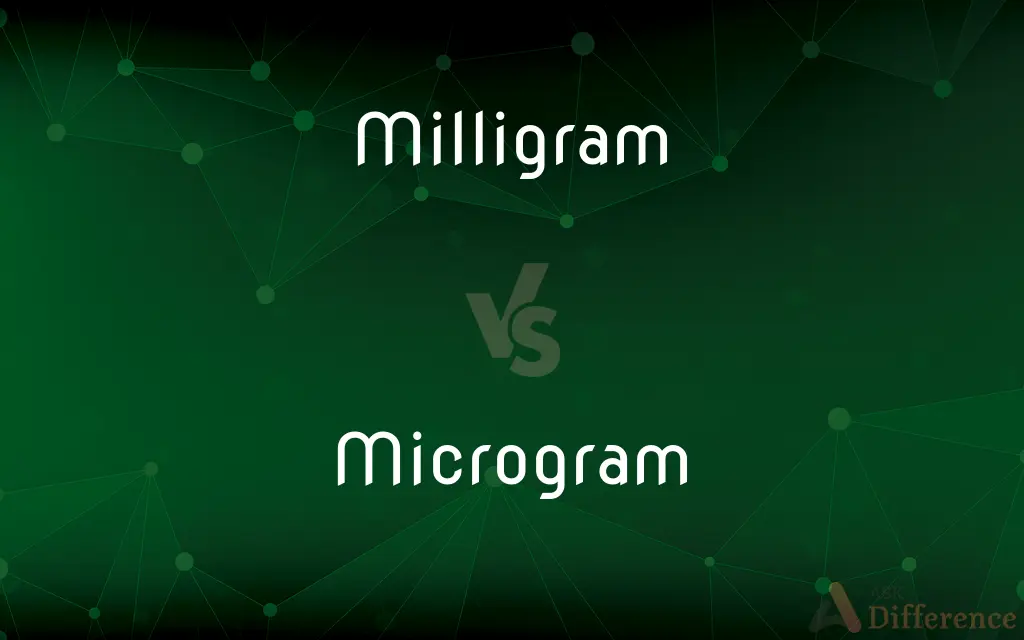Milligram vs. Microgram — What's the Difference?
By Tayyaba Rehman & Urooj Arif — Updated on April 16, 2024
A milligram is a unit of mass equal to one thousandth of a gram, while a microgram is one thousand times smaller, equal to one millionth of a gram.

Difference Between Milligram and Microgram
Table of Contents
ADVERTISEMENT
Key Differences
A milligram (mg) is a unit of mass in the metric system, commonly used in medicine and science to measure small quantities. On the other hand, a microgram (µg or mcg) is an even smaller unit of mass, used extensively when even more precision is required, such as in pharmaceutical dosages or chemical reactions.
Milligrams are suitable for measuring things that are small, but not extremely tiny, such as a grain of sugar. Conversely, micrograms are used to measure much smaller quantities, like the amount of a hormone in a blood sample.
When it comes to medication, dosages in milligrams are common for over-the-counter drugs and prescriptions that require a relatively larger dose. Whereas micrograms are used for drugs that are potent in very small quantities, demonstrating how potency does not directly correlate with mass.
In nutrition, dietary elements like vitamins and minerals might be measured in milligrams, but trace elements which are needed in very small amounts are often measured in micrograms. This illustrates the practical application of each unit based on necessity.
While the difference in scale might seem small, it is critical in scientific and medical contexts. For example, confusing milligrams with micrograms can result in a dosage error by a factor of a thousand, potentially leading to serious or even fatal consequences.
ADVERTISEMENT
Comparison Chart
Equivalent
0.001 grams (1/1,000 of a gram)
0.000001 grams (1/1,000,000 of a gram)
Common Uses
Medicine dosages, food, and science
Highly potent drug dosages, scientific measurements
Precision
Less precise than micrograms
More precise, suitable for very small quantities
Scale
Larger than a microgram
Smaller, requiring careful measurement
Example Usage
Measuring table salt or dietary supplements
Measuring hormones or potent drugs
Compare with Definitions
Milligram
A unit of mass equal to one thousandth of a gram.
The tablet contains 500 milligrams of acetaminophen.
Microgram
A unit of mass equal to one millionth of a gram.
The dosage of the medication is 300 micrograms per tablet.
Milligram
Commonly used to measure non-prescription drug quantities.
He added 200 milligrams of sodium to the solution.
Microgram
Necessary in research for measuring minute quantities.
They detected 2 micrograms of the chemical in the sample.
Milligram
Suitable for everyday scientific measurements.
The sample was weighed to a precision of 10 milligrams.
Microgram
Common in the measurement of dietary supplements when only a trace amount is needed.
Each pill contains 400 micrograms of Vitamin B12.
Milligram
Often used in nutritional information to describe mineral content.
The cereal contains 150 milligrams of calcium per serving.
Microgram
Used in precision tasks where high accuracy is required.
The experiment required the addition of several micrograms of the catalyst.
Milligram
Used in laboratories for measuring common substances.
Each capsule was filled with 250 milligrams of the powdered herb.
Microgram
Used for measuring extremely small amounts in medical prescriptions.
The vaccine contains 5 micrograms of the active substance.
Milligram
A unit of mass equal to one thousandth (10-3) of a gram. See Table at measurement.
Microgram
In the metric system, a microgram or microgramme is a unit of mass equal to one millionth (1×10−6) of a gram. The unit symbol is μg according to the International System of Units; the recommended symbol in the United States and United Kingdom when communicating medical information is mcg.
Milligram
An SI unit of mass, equivalent to one thousandth of a gram. Symbol: mg
Microgram
A unit of mass equal to one thousandth (10-3) of a milligram or one millionth (10-6) of a gram.
Milligram
A measure of weight, in the metric system, being the thousandth part of a gram, equal to the weight of a cubic millimeter of water, or .01543 of a grain avoirdupois.
Microgram
A unit of mass equal to one millionth of a gram, or 0.000 001 grams.
Milligram
One thousandth (1/1,000) gram
Microgram
One millionth (1/1,000,000) gram
Common Curiosities
What is a milligram used for?
Milligrams are used to measure small, but not minuscule, amounts of a substance, such as in medicine, cooking, and nutrition.
What is a microgram used for?
Micrograms measure extremely small amounts, crucial in pharmaceuticals, scientific research, and any application requiring high precision.
How are these units typically measured?
Both units are measured using precise scales that can accurately measure small weights.
Which unit is smaller, milligram or microgram?
The microgram is smaller; it is one thousandth of a milligram.
What common mistakes occur with these measurements?
Common mistakes include confusing the units, leading to a 1,000-fold error.
How do the uses of milligrams and micrograms differ in medicine?
Milligrams are used for general medication dosages, while micrograms are used for highly potent substances.
Can milligrams and micrograms be converted?
Yes, 1 milligram is equal to 1,000 micrograms.
Why is it important to distinguish between milligrams and micrograms?
Misunderstanding these units can lead to significant errors in medication dosages and chemical measurements.
Are there visual examples to understand milligrams and micrograms?
Visual examples might include comparing a small pinch of salt (milligram) versus a tiny speck you can barely see (microgram).
What devices are used to measure milligrams and micrograms?
Analytical balances and microbalances are used for measuring milligrams and micrograms, respectively.
Why are micrograms important in dietary supplements?
Some nutrients are effective at very low levels, which are best measured in micrograms.
What should be considered when converting milligrams to micrograms?
Precision in conversion is critical to avoid dosage and measurement errors.
In what scenarios are milligrams preferred over micrograms?
Milligrams are preferred when larger quantities are involved, such as in food supplements and less potent drugs.
How can one ensure accuracy when using these measurements?
Use calibrated scales and double-check conversions and calculations.
What is the significance of understanding these units in a scientific context?
Accurate understanding and usage are crucial for conducting precise and valid experiments.
Share Your Discovery

Previous Comparison
Brazier vs. Brazer
Next Comparison
Cellphone vs. SmartphoneAuthor Spotlight
Written by
Tayyaba RehmanTayyaba Rehman is a distinguished writer, currently serving as a primary contributor to askdifference.com. As a researcher in semantics and etymology, Tayyaba's passion for the complexity of languages and their distinctions has found a perfect home on the platform. Tayyaba delves into the intricacies of language, distinguishing between commonly confused words and phrases, thereby providing clarity for readers worldwide.
Co-written by
Urooj ArifUrooj is a skilled content writer at Ask Difference, known for her exceptional ability to simplify complex topics into engaging and informative content. With a passion for research and a flair for clear, concise writing, she consistently delivers articles that resonate with our diverse audience.














































